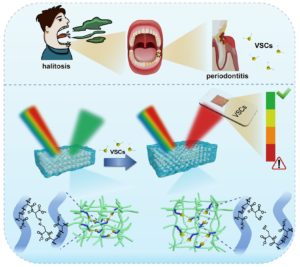Currently, the staging and grading of periodontitis are the basis for effective treatment which relies on professional and complicated oral examinations. As such, there lacks an efficient strategy for the screening of periodontitis. Oral pathogens can produce volatile sulfur compounds (VSCs) which cause halitosis, and which can also act as biomarkers for periodontitis. High-sensitivity detection of exhaled VSCs is urgently desired for promoting the point-of-care testing (POCT) of halitosis and screening of periodontitis. However, current detection methods often require bulky and costly instruments, as well as professional training, making them impractical for widespread detection.
To promote the POCT of VSCs, Hu et al. recently reported a structural color hydrogel for naked-eye detection of oral pathogens, diagnosis of halitosis, and screening of periodontitis (Figure 1). They employed a disulfide-containing molecule N,N’-bis(acryloyl)-(L)-cystine (BISS) as a VSC-responsive crosslinker within a polyacrylamide (PAAm) hydrogel network and introduced the hydrogel into a photonic crystal structure. The disulfide bonds in the hydrogel can be reduced to sulfhydryl groups by VSCs, leading to cleaved crosslinkers and thus a decreased crosslink density. As a result, the hydrogel swells, leading to a red shift of the Bragg diffraction wavelength, causing a corresponding change in the structural color of the photonic crystal. The structural color hydrogel is capable of linear detection of 0–1 ppm VSCs, which covers the typical concentration of VSCs exhaled by patients with periodontitis, and a limit of detection (LOD) of 61 ppb to H2S can be achieved. Via real-time and in-situ sensing of the VSCs produced by porphyromonas gingivalis, the proliferation process can be visually monitored, which shows consistent results with the commonly used turbidimetric method. On this basis, the structural color hydrogel is applied to detect exhaled VSCs of patients with halitosis, showing results consistent with the clinical diagnosis. By integrating hydrogels of various colors into a sensor array, the oral health conditions of patients with halitosis can be evaluated and distinguished, offering a risk assessment of periodontitis.

Figure 1: Schematic illustration of the structural color hydrogel for diagnosis of halitosis and screening of periodontitis. Exhaled VSCs reduce the disulfide bonds to sulfhydryl groups within the hydrogel network, leading to expansion and color shift of the hydrogel. A higher concentration of VSCs suggests severe halitosis and a higher risk of periodontitis. Reproduced from DOI: 10.1039/d3mh01563g with permission from the Royal Society of Chemistry.
In summary, compared with the state-of-the-art detection methods, the structural color hydrogel has the potential for employment in low-cost, high-sensitivity, and high-accuracy point-of-care diagnosis of halitosis and screening of periodontitis without bulky instruments and power sources. This opens a door to an auxiliary diagnosis of periodontitis and has great significance for stomatology.
To find out more, please read:
A structural color hydrogel for diagnosis of halitosis and screening of periodontitis
Chuanshun Hu, Jieyu Zhou, Jin Zhang, Yonghang Zhao, Chunyu Xie, Wei Yin, Jing Xie, Huiying Li, Xin Xu, Lei Zhao, Meng Qin and Jianshu Li
Mater. Horiz., 2024, Advance article, DOI: 10.1039/d3mh01563g
About the blogger

Jing Xie is currently an Associate Professor at Sichuan University and a member of the Materials Horizons Community Board. Dr. Xie focuses on the exploration and preparation of polymer materials and their composites, with a focus on the biological domain, particularly within the context of bone-related ailments, including osteoarthritis, bone defects, and others. |










